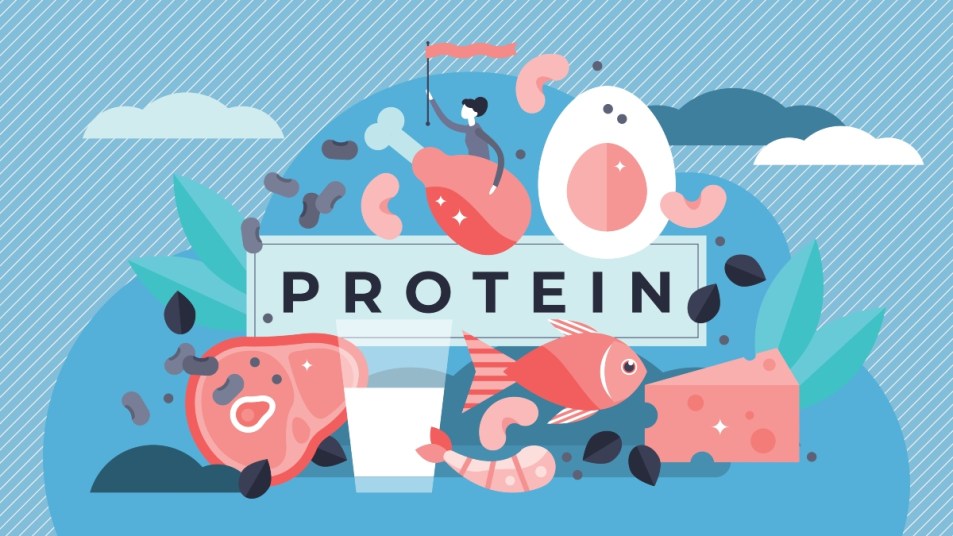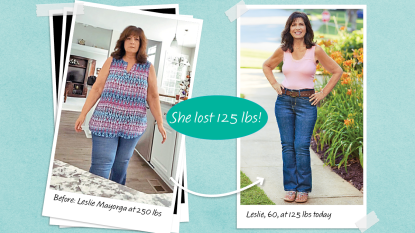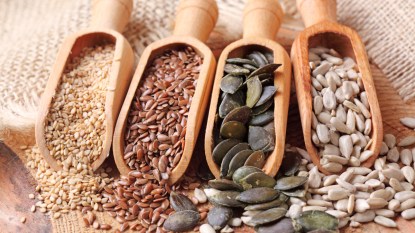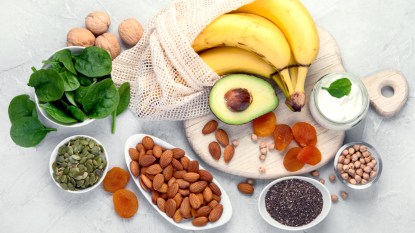Science Says *This* Is How Much Protein Woman Need to Eat in a Week
Protein is powerful.

When I started my fitness journey, both men and women told me to eat more protein. But given the differences between mens’ and womens’ bodies and needs, I wondered what this actually meant. How much protein was the right amount for women, specifically? In fact, there are different protein recommendations for men and women. Below are findings from several studies on the correct protein intake for women, as well as an in-depth look at protein’s function and why it’s so important. Here, how much protein women need to eat in a week.
Protein: the building block of life
Dietary protein is one of three macronutrients our bodies need to function. (The other two are carbohydrates and fats.) Protein builds and repairs tissue, tissue, skin, and hair. It also plays a vital role in hormone production, metabolic processes, and several enzymatic reactions. Not getting enough protein can lead to a host of health problems, such as:
- Muscle wasting
- Fatigue
- Mood disturbances
- Weak immune system
- Hormonal imbalances
Common signs of a protein deficiency include pale skin, swelling in the extremities, thinning hair, brittle nails, and slow wound healing. If you experience these symptoms or suspect you are not getting enough protein, talk to your doctor.
What is protein’s role in women’s health?
When it comes to women’s health, protein is especially important. That’s because it does the following:
Promotes hormonal balance
Protein supports the production of hormones, which are essential for women’s reproductive health. Specifically, a protein called globulin binds to sex hormones such as estrogen and progesterone, helping transport the hormones through the bloodstream. Balanced hormones are crucial for regulating your menstrual cycle and reducing PMS symptoms.
Aids in muscle growth and recovery
Another important role protein plays in women’s health is its ability to aid in muscle growth and recovery. Exercise creates small tears in our muscle fibers. These tears are then repaired by our body using amino acids from the protein we consume. Consuming enough protein ensures that muscles recover quickly from exercise and continue to grow strong over time.
Provides essential nutrients
Protein is an excellent source of essential nutrients such as iron, zinc, and B vitamins that the female body requires for optimal health. These nutrients are vital for functions such as oxygen transportation, blood sugar regulation, and hormone synthesis. Consuming adequate protein in your diet promotes overall health and reduces the risk of nutrient deficiencies.
Supports bone and joint health
Research shows that consuming enough protein each day is associated with increased bone density and a reduced risk of osteoporosis in women. Proteins also make up crucial components for tendons, cartilage, and ligaments — all key parts of our joints! By ensuring you eat enough protein, you help to improve joint function, reduce your risk of injury, and improve your overall health.
Enhances brain function
Protein is essential for cognitive function and can help improve memory and mood. Protein consumption helps to build neurotransmitters, such as dopamine and serotonin, which can enhance your ability to concentrate and stay focused. Amino acids found in protein are also essential to produce mood-regulating neurotransmitters.
Boosts metabolism
Another significant role protein plays in women’s health is its ability to boost metabolism and weight loss. Studies have found that higher protein intake can reduce cravings, increase the number of calories burned during digestion, and generally contribute to feeling fuller for longer. Making sure to have adequate protein in your diet can help you reach your body composition goals and maintain a healthy weight.
Increases energy levels
Protein helps regulate blood sugar levels, which in turn, helps to stabilize our energy throughout the day. Eating protein at regular intervals keeps us fueled and prevents energy crashes.
Bolsters immunity
Finally, protein plays a critical role in immune function, helping to produce antibodies that protect us from illness. By consuming enough protein, we help our bodies effectively fight off infection and disease.
How much protein do women need daily?
Experts generally recommend that women should consume 0.8 grams of protein per kilogram of body weight (or around 0.36 grams per pound). This means that a woman who weighs 140 pounds should consume approximately 50 grams of protein daily. This, of course, is an estimate. Your individual needs will vary depending on factors like activity level and fitness goals. Consult your doctor or dietician for personalized nutrition advice.
What factors influence women’s protein needs?
The factors that can influence a woman’s protein needs include:
Body composition
Women who have more muscle mass require more protein than those who have less muscle. This is because muscle tissue is made up of amino acids, the building blocks of protein. If you’re lifting weights or doing regular strength training, you’ll need more protein than someone who only does cardio or yoga. Per general guidelines, active women may want to aim for 0.8 to 1.2 grams of protein per pound of body weight daily.
Age
Age is another crucial factor that has an impact on women’s protein requirements. Our muscle mass naturally declines as we age, and our bodies process protein less efficiently. This means that as we age, we require more protein to maintain muscle mass and prevent age-related muscle loss. Women over 50 should typically aim for 1.2 to 1.7 grams of protein per kilogram of body weight per day.
Menstrual cycle
Your menstrual cycle can influence your protein needs. During the luteal phase of a woman’s cycle, the body generally requires more energy and nutrients to support the potential growth of a fertilized egg. This means that your protein needs will likely increase slightly during this time. Some experts recommend increasing protein intake by 10 to 20 percent during the luteal phase to support hormone balance and reduce PMS symptoms.
Pregnancy and breastfeeding
Women who are pregnant or breastfeeding also have higher protein requirements. Protein is needed to support the growth and development of a healthy fetus or infant, as well as to produce breast milk. Experts generally recommend that pregnant and lactating women consume 1.1 grams of protein per kilogram of body weight per day.
Health conditions
Finally, certain health conditions can impact women’s daily protein needs. Those with chronic illnesses, such as diabetes or kidney disease, may need more or less protein than others. Additionally, women who are recovering from surgery or injuries may require more protein to support tissue repair and healing. Consult your doctor for advice.
What are some tips to increase your protein intake?
Below are five tips for increasing your protein intake:
1. Include more protein-packed foods on your plate
Excellent sources of protein include cottage cheese; lean meats like chicken breast, fish, and turkey; and plant-based proteins such as nuts, seeds, quinoa, and legumes like black beans, lentils, and chickpeas. Try to build meals around these high-protein foods and whole grains, and aim to have at least one source of protein with every meal throughout the day. Following dietary guidelines for protein is an important part of healthy eating, whether that’s naturally occurring animal protein or adding a little whey protein to your next smoothie.
2. Snack wisely
When we think of snacks, we often think of things like chips, candy, or other carb-heavy treats. However, there are plenty of great-tasting snack options out there that are high in protein. Those in the healthy diet category include hard-boiled eggs, Greek yogurt, and protein bars.
3. Add protein powder to your favorite recipes
Protein powder isn’t just for fitness enthusiasts or bodybuilders looking to build muscle. It can be an effective way to boost the protein content of your favorite recipes, from smoothies to pancakes. There are many types of protein powders to choose from, including whey, casein, and plant-based options like soy or pea protein. Experiment with different flavors and textures to find the one that works best for you. (Click through for The Best Belly-Flattening Protein Powders for Women In Their 40s, 50s, 60s and Beyond and Recipes Using Vanilla Protein Powder That Aren’t Smoothies.)
4. Plan ahead for busy days
We’ve all had those times where it feels like there aren’t enough hours in the day to get everything done. That’s when the temptation to grab fast food or skip meals is greatest. Planning ahead safeguards you against this temptation by ensuring that you have plenty of protein-rich foods on hand, even when you’re short on time. Try prepping meals and snacks in advance so that healthy and filling foods are always on hand.
5. Consider supplements
Supplements can be a helpful tool for those who struggle with incorporating sufficient protein into their diet. Popular protein supplements include whey, casein, and plant-based options like soy or pea protein, all of which can be added to shakes and smoothies or used to make high-protein desserts like pudding and protein bars. (Click through for the The 19 Best Vegan Protein Powders.)
Key Takeaways
Protein is an essential nutrient for women of all ages. To ensure optimal health and performance, it’s important to consume enough quality protein every day. If you don’t know how much protein you should consume, speak to your physician. Taking the time to ensure you’re getting enough protein now lays the groundwork for your future health and well-being.
For more on how to work in extra protein to your diet:
Protein Brownies: Women Over 50 Are Eating Them for Breakfast and Losing 100+ Lbs
Women Over 50 Are Going Crazy for Protein Coffee — And Weight Loss Is Only One Reason













